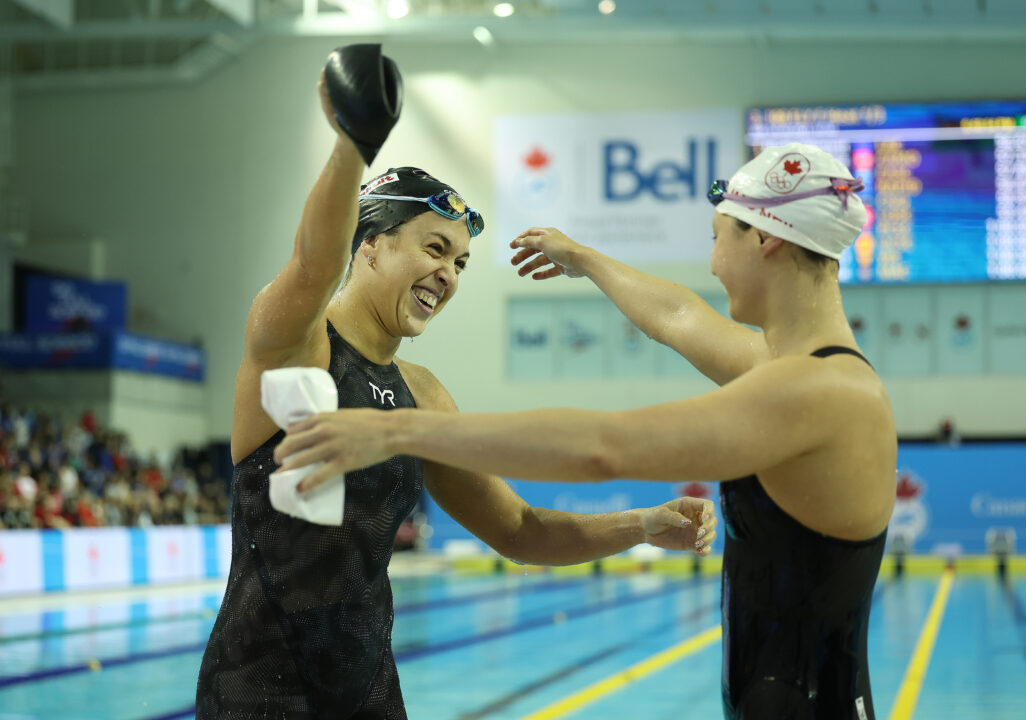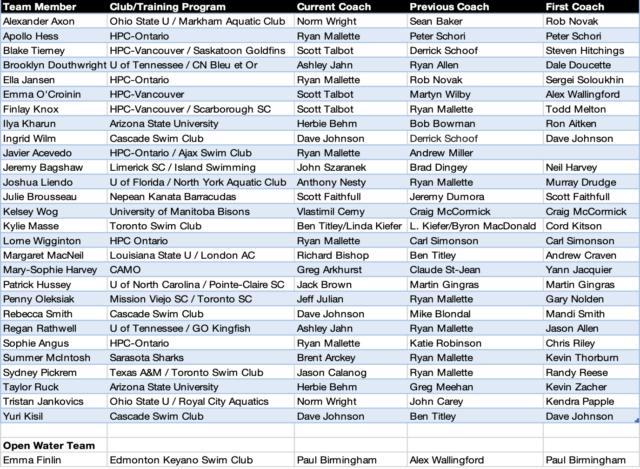Courtesy: John Atkinson, Swimming Canada High Performance Director National Coach / Swimming Canada
Following last month’s Olympic & Paralympic Trials, Presented by Bell, 28 swimmers have been nominated to the Canadian Olympic Committee to compete at the Paris 2024 Olympic Games in the pool. They will join our open water marathon swimmer who qualified from the Doha 2024 World Aquatics Championships.
While these 29 swimmers will represent Canada in Paris, so many people and factors have contributed to their journey. Before we travel to France for the Games in just a few short weeks, I would like to recognize some important aspects of how a swimmer develops all the way to the Olympic Team.
Recognizing the coaching pathway
We all know many years of preparation go into every athlete making the Olympic Team. They rely on the support of family and friends along the way, as well as a pathway of coaches who have had an impact on the performance of every swimmer being nominated.
Back in 2016 we started to recognize the chain of coaches who have helped develop each of the Swimming Canada nominated athletes to the Olympic team, and we do that again this year as we prepare for Paris.
We recognize on the full team list below three coaches for each athlete:
- Current Coach is the athlete’s primary coach this season who was coaching them at the point of making the team.
- Previous Coach was the athlete’s primary coach immediately before their current coach.
- First Coach coached the athlete to their first senior swimming championships or Trials in Canada.
For the 2024 Olympic Swimming Team, 60 different coaches have been part of the journey for our athletes as the current, previous or first coach. We also acknowledge other coaches have helped along the way, including as the primary coach of some athletes. We thank them all for their part in developing each athlete on the team.
Swimming Canada is proud to recognize all the coaches contributing to our team this year and continues to work with the coaches of our Canadian team members wherever they are based.
Recognizing the national development team pathway
When looking at the team, we also see a trend of involvement at the National Development Team Program level:
- 16 of the 29 swimmers have previously competed at world junior championships (pool and/or open water)
- 16 of the 28 pool swimmers have previously competed at the Junior Pan Pacific Championships
- 21 of the 29 swimmers (72.4%) have previously competed at either of the above
- 25 of the 29 (86.2%) have previously competed at one of the above and/or another NDTP competition such as the Youth Olympic Games, a UANA or LEN open water event, or a past World Swimming Championships (25m) when selected as a development swimmer
In addition, two young swimmers bypassed the NDTP by qualifying straight on to a senior team while still eligible as juniors. So of the remaining 27 swimmers, 92.5% progressed to the Olympic Team thanks in part to at least one NDTP opportunity.
These statistics clearly demonstrate the value of the National Development Team Program as a proving ground for our Olympic Team. These opportunities are part of the swimmer development pathway Swimming Canada, Own the Podium, Sport Canada and the Canadian Olympic Committee work together to support. The pathway is designed to offer relevant development team opportunities and allow junior-aged swimmers to learn and develop along the journey.
The strategy of individual paths converging
In the 2023-2024 season 14 swimmers who went on to make the Olympic team competed at the Pan American Games in Santiago, Chile, and 12 swimmers competed at the World Aquatics Championships in Doha, Qatar. Knowing how crowded the competition calendar was this last 12 months we took the approach that all swimmers would be on their own path and all the paths would converge at the Olympic Trials in May 2024. This strategic approach allowed swimmers and their coaches to consider their own individualized plans to the Olympic Trials. Some competed at the 2023 worlds in Japan, some also competed at the World Junior Championships in September and prepared for Trials focused on training. Others competed in Santiago or Doha, some did both. This has been a sensible strategy, trusting each swimmer and their coaches to prepare to be their best for Canada at the Paris 2024 Olympic Games. While it’s certainly not ‘job done,’ we are pleased to see how these bespoke plans have converged, with 29 individual plans coming together as a team. It is now about focus as we keep moving towards Paris and the Games.
The important role of High Performance Centres
21 of the 29 swimmers (72.4%) train or have trained at a Swimming Canada High Performance Centre for significant periods in their career when they were successful and/or made significant improvement. This without doubt shows the value of the HPCs for Swimming Canada as a whole and we look forward to continuing to support athletes in the centres. The centres are the base, through the Canadian Olympic and Paralympic Sport Institute Network, for many of our support staff for our program. This valuable partnership, supplemented by our contractor professionals, has provided us the ability to develop world-class daily training environments in the centres, which carries over to our teams.
A further two of the 29 swimmers have been training members of the Ontario Swimming Academy, which is aligned with HPC-Ontario and supported in partnership between Swim Ontario and Swimming Canada.
HPC Head Coaches Ryan Mallette (5) and Scott Talbot (3) led the way among the 19 coaches placing swimmers on the 2024 Canadian Olympic Swimming Team:
| Coach | Program | Swimmers on the Team |
| Ryan Mallette | HPC-Ontario | 5 |
| Scott Talbot | HPC-Vancouver | 3 |
| Dave Johnson | Cascade Swim Club | 3 |
| Norm Wright | Ohio State University | 2 |
| Ashley Jahn | University of Tennessee | 2 |
| Herbie Behm | Arizona State University | 2 |
| Paul Birmingham | Edmonton Keyano SC | 1 |
| Vlastimil Cerny | U of Manitoba Bisons | 1 |
| Greg Arkhurst | CAMO | 1 |
| Brent Arckey | Sarasota Sharks | 1 |
| Ben Titley & Linda Kiefer | University of Toronto | 1 |
| Scott Faithfull | Nepean Kanata Barracudas | 1 |
| Rick Bishop | Louisiana State University | 1 |
| John Szaranek | University of Limerick | 1 |
| Jack Brown | University of North Carolina | 1 |
| Anthony Nesty | University of Florida | 1 |
| Jeff Julian | Mission Viejo Swim Club | 1 |
| Jason Calanog | Texas A&M University | 1 |
Recent success stories include Sophie Angus, who was contemplating retirement but chose to move to HPC-Ontario. She has since posted personal best times and been an important contributor to two medley relay medals at World Aquatics Championships: https://www.swimming.ca/en/news/2023/09/22/decision-not-to-retire-rewarded-by-world-medal/
Swimming Canada is also promoting a new and enhanced scholarship program with a goal of giving identified NextGen swimmers an opportunity to develop their talents in Canada at one of the centres: https://www.swimming.ca/en/news/2024/05/03/new-scholarship-program-aimed-at-attracting-swimmers-to-centres/
Athletes interested in Swimming Canada High Performance Centres can find more information here


So telling that you can compose an article on this subject and of this length without using NCAA or Usports explicitly. Nothing more than a commercial for HPC recruitment, image repair and defending the HPC coaches. The Ontario Swim Academy, is there actually a roster of who attends this program don’t think I have seen anything published in years? How can the cost of the HPCs and Ontario Swim Academy be justified given the number of attendees. Seems like if we build it they do not come.
This just seems like another ploy to try and downplay how much of a mistake it was to let Titley walk. Really undersells how much work he did to build the team into what it is today. While I do think the Mallette hate is a little excessive, having him listed as the “primary” coach for Oleksiak, Liendo and Mcintosh is outrageous. We all know who played a bigger role in the development of those three world-class swimmers.